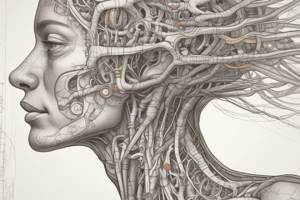Podcast
Questions and Answers
Which structure does the sympathetic pathway for skin originate from?
Which structure does the sympathetic pathway for skin originate from?
- Peripheral Trunk
- Cervical Ganglia
- Spinal Cord (T1-L2) (correct)
- Brainstem
What is the role of the postganglionic neuron in the sympathetic pathway for the organs of the head and neck?
What is the role of the postganglionic neuron in the sympathetic pathway for the organs of the head and neck?
- To synapse before exiting through the celiac plexus
- To travel directly to thoracic organs
- To innervate the ciliary muscle and dilator pupillae (correct)
- To release neurotransmitters at the spinal cord
Which sympathetic ganglia are involved in innervating thoracic organs from T1 to T5?
Which sympathetic ganglia are involved in innervating thoracic organs from T1 to T5?
- Sacral Ganglia
- Superior cervical ganglia to T5 (correct)
- Cervical Ganglia only
- Lumbar Ganglia
What type of nerves leave the sympathetic trunk to innervate thoracic organs?
What type of nerves leave the sympathetic trunk to innervate thoracic organs?
What is the pathway for sympathetic innervation of the abdominopelvic organs?
What is the pathway for sympathetic innervation of the abdominopelvic organs?
What structure do sympathetic fibers traveling to the skin synapse with before innervation?
What structure do sympathetic fibers traveling to the skin synapse with before innervation?
Which of these organs does not receive sympathetic innervation directly via fibers from T1-T5?
Which of these organs does not receive sympathetic innervation directly via fibers from T1-T5?
What is the pathway of sympathetic nerves to the skin once they exit the sympathetic trunk?
What is the pathway of sympathetic nerves to the skin once they exit the sympathetic trunk?
What anatomical structure allows sympathetic fibers to travel from the spinal cord to the sympathetic trunk?
What anatomical structure allows sympathetic fibers to travel from the spinal cord to the sympathetic trunk?
Which component is part of the sympathetic pathway for the heart?
Which component is part of the sympathetic pathway for the heart?
Flashcards
Sympathetic Pathway to Skin
Sympathetic Pathway to Skin
Spinal cord (T1-L2) sends preganglionic fibers to sympathetic trunk, synapse in paravertebral ganglia, and postganglionic fibers leave via gray rami to innervate skin (sweat glands, arrector pili muscles, blood vessels).
Sympathetic Pathway to Head and Neck
Sympathetic Pathway to Head and Neck
Spinal cord (T1-T5) fibers travel superiorly in sympathetic trunk to superior cervical ganglia, synapse, and postganglionic fibers innervate head and neck organs (ciliary muscle, dilator pupillae, carotid sinus).
Sympathetic Pathway to Thoracic Organs
Sympathetic Pathway to Thoracic Organs
Spinal cord (T1-T5) fibers synapse in paravertebral ganglia (superior cervical up to T5) and postganglionic fibers travel via cardiopulmonary splanchnic nerves to the heart and lungs.
Splanchnic Nerves
Splanchnic Nerves
Signup and view all the flashcards
White Ramus
White Ramus
Signup and view all the flashcards
Gray Ramus
Gray Ramus
Signup and view all the flashcards
Paravertebral Ganglia
Paravertebral Ganglia
Signup and view all the flashcards
Preganglionic Fiber
Preganglionic Fiber
Signup and view all the flashcards
Postganglionic Fiber
Postganglionic Fiber
Signup and view all the flashcards
Sympathetic Trunk
Sympathetic Trunk
Signup and view all the flashcards
Study Notes
Sympathetic Nervous System Pathways
- Skin Pathway:
- Spinal Cord (T1-L2) → Sympathetic Trunk/Paravertebral Ganglia (all levels) → Peripheral Nerves → Skin (sweat glands, arrector pili muscles, and blood vessels).
- Fibers may stay at the same spinal level (T1-L2) or travel superior or inferior within the sympathetic trunk to reach target spinal levels.
- Synapses occur on postganglionic neurons in paravertebral ganglia before fibers leave the sympathetic trunk via gray rami.
- Peripheral nerves innervate the dermatomes of the skin, including sweat glands, arrector pili muscles, and blood vessels.
Organs of the Head and Neck
- Pathway:
- Spinal Cord (T1-T5) → Sympathetic Trunk/Paravertebral Ganglia (superior cervical ganglia) → Cephalic Arterial Branch (splanchnic nerve) → Organs of the Head & Neck (ciliary muscle, dilator pupillae, sensory from carotid sinus).
- Fibers travel superiorly through the white rami to reach the superior cervical ganglia.
- Synapse on postganglionic neurons before leaving via the cephalic arterial branch.
- Innervate organs including the ciliary muscle, dilator pupillae, and sensory areas from the carotid sinus.
Thoracic Organs
-
Pathway:
- Spinal Cord (T1-T5) → Sympathetic Trunk/Paravertebral Ganglia (superior cervical ganglia to T5) → Cardiopulmonary Splanchnic Nerves → Thoracic Organs.
-
Fibers enter the sympathetic trunk and synapse in paravertebral ganglia from superior to T5.
-
Some fibers travel superior, middle, or inferior to reach their destination.
-
Fibers leaving the trunk travel via trunk cardiopulmonary splanchnic nerves.
-
Lungs:
- Fibers enter the sympathetic trunk, synapse on postganglionic neurons, and leave via cardiopulmonary splanchnic nerves at the same level (T1-T5).
Abdominopelvic Organs
- Pathway:
- Spinal Cord (T5-L2) → Sympathetic Trunk → Splanchnic Nerves (e.g., greater, lesser, least thoracic and lumbar) → Prevertebral Ganglia (e.g., celiac, superior mesenteric ganglia) → Abdominopelvic Organs.
- Fibers enter the sympathetic trunk (via white rami) and may travel inferiorly or leave immediately as splanchnic nerves.
- Splanchnic nerves reach prevertebral ganglia, where they synapse on postganglionic neurons to reach target organs.
- Target Organs include, but are not limited to: stomach, liver, gallbladder, spleen, and pancreas (Greater thoracic ganglia T5-T9 → Celiac paravertebral ganglion).
- Other ganglia and targets include: Aorticorenal paravertebral ganglion (T10-T11), kidney, and suprarenal (adrenal) glands (Least thoracic T12); superior mesenteric paravertebral ganglion, proximal GI tract; inferior mesenteric ganglia, distal GI tract, bladder, and reproductive organs (L1-L2/3); and pelvic organs (sacral splanchnic nerves).
Studying That Suits You
Use AI to generate personalized quizzes and flashcards to suit your learning preferences.




